Untangle the Complex Stakeholder Relationships in Rural Settlement Consolidation in China: A Social Network Approach
Abstract
1. Introduction
2. Research Background and Literature Review
2.1. Rural Settlement Consolidation (RSC) Stakeholders
2.2. Interest Concerns of RSC Stakeholders
3. Methodology
3.1. Social Network Analysis
3.2. Study Area
3.3. Data Collection
4. Results
4.1. Results of Social Network Visualization and Status Centrality Analysis
4.2. Identification of Key Stakeholders’ Concerns and Relationships
4.3. Interaction Type and Implementing Guidance
5. Discussion
5.1. Recognition of the Engineering Aspect of RSC
5.2. Encouragement of Stakeholder Interaction in RSC
5.3. Emphasis on Preserving the Features and Landscape of Rural Settlements
6. Conclusions
Author Contributions
Funding
Conflicts of Interest
References
- Bathrellos, G.D.; Gaki-Papanastassiou, K.; Skilodimou, H.D.; Skianis, G.A.; Chousianitis, K.G. Assessment of rural community and agricultural development using geomorphological-geological factors and GIS in the Trikala prefecture (Central Greece). Stoch. Environ. Res. Risk Assess. 2013, 27, 573–588. [Google Scholar] [CrossRef]
- Topole, M.; Bole, D.; Petek, F.; Repolusk, P. Spatial and functional changes in built-up areas in selected slovene rural settlements after 1991. Acta Geogr. Slov. 2006, 46, 189–249. [Google Scholar] [CrossRef]
- Long, H.; Li, Y.; Liu, Y.; Woods, M.; Zou, J. Accelerated restructuring in rural China fueled by ‘increasing vs. decreasing balance’ land-use policy for dealing with hollowed villages. Land Use Policy 2012, 29, 11–22. [Google Scholar] [CrossRef]
- Gkartzios, M.; Scott, M. Attitudes to housing and planning policy in rural localities: Disparities between long-term and mobile rural populations in Ireland. Land Use Policy 2013, 31, 347–357. [Google Scholar] [CrossRef]
- Di Figlia, L. Turnaround: Abandoned villages, from discarded elements of modern Italian society to possible resources. Int. Plan. Stud. 2016, 21, 278–297. [Google Scholar] [CrossRef]
- Prunty, M.C. Idle Rural Land Phenomena in Madison County, Georgia. Southeast. Geogr. 1961, 1, 39–49. [Google Scholar] [CrossRef]
- Liu, Y.; Liu, Y.; Chen, Y.; Long, H. The process and driving forces of rural hollowing in China under rapid urbanization. J. Geogr. Sci. 2010, 20, 876–888. [Google Scholar] [CrossRef]
- Gladwin, C.H.; Long, B.F.; Babb, E.M.; Beaulieu, L.J.; Moseley, A.; Mulkey, D.; Zimet, D.J. Rural Entrepreneurship: One Key to Rural Revitalization. Am. J. Agric. Econ. 1989, 71, 1305–1314. [Google Scholar] [CrossRef]
- Knight, J. Rural Revitalization in Japan: Spirit of the Village and Taste of the Country. Asian Surv. 1994, 34, 634–646. [Google Scholar] [CrossRef]
- Liu, Y.; Li, Y. Revitalize the world’s countryside. Nature 2017, 548, 275–277. [Google Scholar] [CrossRef] [PubMed]
- Tian, Y.; Liu, Y.; Kong, X. Restructuring rural settlements based on mutualism at a patch scale: A case study of Huangpi District, central China. Appl. Geogr. 2018, 92, 74–84. [Google Scholar] [CrossRef]
- Gorbenkova, E.; Shcherbina, E. Historical-Genetic Features in Rural Settlement System: A Case Study from Mogilev District (Mogilev Oblast, Belarus). Land 2020, 9, 165. [Google Scholar] [CrossRef]
- Tu, S.; Long, H. Rural restructuring in China: Theory, approaches and research prospect. J. Geogr. Sci. 2017, 27, 1169–1184. [Google Scholar] [CrossRef]
- Long, H.; Tu, S.; Ge, D.; Li, T.; Liu, Y. The allocation and management of critical resources in rural China under restructuring: Problems and prospects. J. Rural Stud. 2016, 47, 392–412. [Google Scholar] [CrossRef]
- Jin, X.; Xu, X.; Xiang, X.; Bai, Q.; Zhou, Y. System-dynamic analysis on socio-economic impacts of land consolidation in China. Habitat Int. 2016, 56, 166–175. [Google Scholar] [CrossRef]
- Gedefaw, A.A.; Atzberger, C.; Seher, W.; Mansberger, R. Farmers willingness to participate in voluntary land consolidation in Gozamin District, Ethiopia. Land 2019, 8, 148. [Google Scholar] [CrossRef]
- Wang, G.; Wu, P.; Wu, X.; Zhang, H.; Guo, Q.; Cai, Y. Mapping global research on sustainability of megaproject management: A scientometric review. J. Clean. Prod. 2020, 259, 120831. [Google Scholar] [CrossRef]
- Liu, W.; Yang, C.; Liu, Y.; Wei, C.; Yang, X. Impacts of concentrated rural resettlement policy on rural restructuring in upland areas: A case study of Qiantang Town in Chongqing, China. Land Use Policy 2018, 77, 732–744. [Google Scholar] [CrossRef]
- Yang, R.; Liu, Y.; Long, H.; Qiao, L. Spatio-temporal characteristics of rural settlements and land use in the Bohai Rim of China. J. Geogr. Sci. 2015, 25, 559–572. [Google Scholar] [CrossRef]
- He, Q.; Tan, S.; Yin, C.; Zhou, M. Collaborative optimization of rural residential land consolidation and urban construction land expansion: A case study of Huangpi in Wuhan, China. Comput. Environ. Urban Syst. 2019, 74, 218–228. [Google Scholar] [CrossRef]
- Li, T.; Long, H.; Liu, Y.; Tu, S. Multi-scale analysis of rural housing land transition under China’s rapid urbanization: The case of Bohai Rim. Habitat Int. 2015, 48, 227–238. [Google Scholar] [CrossRef]
- Long, H.; Qu, Y. Land use transitions and land management: A mutual feedback perspective. Land Use Policy 2018, 74, 111–120. [Google Scholar] [CrossRef]
- Lo, K.; Xue, L.; Wang, M. Spatial restructuring through poverty alleviation resettlement in rural China. J. Rural Stud. 2016, 47, 496–505. [Google Scholar] [CrossRef]
- Fang, Y.-G.; Shi, K.-J.; Niu, C.-C. A comparison of the means and ends of rural construction land consolidation: Case studies of villagers’ attitudes and behaviours in Changchun City, Jilin province, China. J. Rural Stud. 2016, 47, 459–473. [Google Scholar] [CrossRef]
- Ma, W.; Jiang, G.; Li, W.; Zhou, T.; Zhang, R. Multifunctionality assessment of the land use system in rural residential areas: Confronting land use supply with rural sustainability demand. J. Environ. Manag. 2019, 231, 73–85. [Google Scholar] [CrossRef]
- Tang, Y.; Mason, R.J.; Sun, P. Interest distribution in the process of coordination of urban and rural construction land in China. Habitat Int. 2012, 36, 388–395. [Google Scholar] [CrossRef]
- Zhang, B.-L.; Jiang, G.-H.; Cai, W.-M.; Sun, P.-L.; Zhang, F.-R. Productive functional evolution of rural settlements: Analysis of livelihood strategy and land use transition in eastern China. J. Mt. Sci. 2017, 14, 2540–2554. [Google Scholar] [CrossRef]
- Yep, R.; Forrest, R. Elevating the peasants into high-rise apartments: The land bill system in Chongqing as a solution for land conflicts in China? J. Rural Stud. 2016, 47, 474–484. [Google Scholar] [CrossRef]
- Tang, Y.; Mason, R.J.; Wang, Y. Governments’ functions in the process of integrated consolidation and allocation of rural–urban construction land in China. J. Rural Stud. 2015, 42, 43–51. [Google Scholar] [CrossRef]
- Cheng, L.; Liu, Y.; Brown, G.; Searle, G. Factors affecting farmers’ satisfaction with contemporary China’s land allocation policy—The Link Policy: Based on the empirical research of Ezhou. Habitat Int. 2018, 75, 38–49. [Google Scholar] [CrossRef]
- Zhao, Q.; Zhang, Z. Does China’s ‘increasing versus decreasing balance’ land-restructuring policy restructure rural life? Evidence from Dongfan Village, Shaanxi Province. Land Use Policy 2017, 68, 649–659. [Google Scholar] [CrossRef]
- Minjun, S.; Hongjuan, W.; Junqi, X.; Zhiyuan, S.; Dingyang, Z. Rural Collective Construction Land Transfer Based on Stakeholder Analysis. J. Resour. Ecol. 2015, 6, 155–163. [Google Scholar] [CrossRef]
- Lerise, F. Centralised spatial planning practice and land development realities in rural Tanzania. Habitat Int. 2000, 24, 185–200. [Google Scholar] [CrossRef]
- Li, Y.; Westlund, H.; Zheng, X.; Liu, Y. Bottom-up initiatives and revival in the face of rural decline: Case studies from China and Sweden. J. Rural Stud. 2016, 47, 506–513. [Google Scholar] [CrossRef]
- Wang, Q.; Zhang, M.; Cheong, K.C. Stakeholder perspectives of China’s land consolidation program: Acase study of Dongnan Village, Shandong Province. Habitat Int. 2014, 43, 172–180. [Google Scholar] [CrossRef]
- Zhang, Z.; Wen, Y.; Wang, R.; Han, W. Factors influencing rural households’ willingness of centralized residence: Comparing pure and nonpure farming areas in China. Habitat Int. 2018, 73, 25–33. [Google Scholar] [CrossRef]
- Liu, Z.; Müller, M.; Rommel, J.; Feng, S. Community-based agricultural land consolidation and local elites: Survey evidence from China. J. Rural Stud. 2016, 47, 449–458. [Google Scholar] [CrossRef]
- Onitsuka, K.; Hoshino, S. Inter-community networks of rural leaders and key people: Case study on a rural revitalization program in Kyoto Prefecture, Japan. J. Rural Stud. 2018, 61, 123–136. [Google Scholar] [CrossRef]
- Kerselaers, E.; Rogge, E.; Vanempten, E.; Lauwers, L.; Van Huylenbroeck, G. Changing land use in the countryside: Stakeholders’ perception of the ongoing rural planning processes in Flanders. Land Use Policy 2013, 32, 197–206. [Google Scholar] [CrossRef]
- Li, Y.; Wu, W.; Liu, Y. Land consolidation for rural sustainability in China: Practical reflections and policy implications. Land Use Policy 2018, 74, 137–141. [Google Scholar] [CrossRef]
- Long, H. Land consolidation: An indispensable way of spatial restructuring in rural China. J. Geogr. Sci. 2014, 24, 211–225. [Google Scholar] [CrossRef]
- Liu, W.; Yang, X.; Zhong, S.; Sissoko, F.; Wei, C. Can community-based concentration revitalise the upland villages? A case comparison of two villages in Chongqing, Southwestern China. Habitat Int. 2018, 77, 153–166. [Google Scholar] [CrossRef]
- Li, Y.; Fan, P.; Liu, Y. What makes better village development in traditional agricultural areas of China? Evidence from long-term observation of typical villages. Habitat Int. 2019, 83, 111–124. [Google Scholar] [CrossRef]
- Gullino, P.; Devecchi, M.; Larcher, F. How can different stakeholders contribute to rural landscape planning policy? The case study of Pralormo municipality (Italy). J. Rural Stud. 2018, 57, 99–109. [Google Scholar] [CrossRef]
- Sisto, R.; Lopolito, A.; van Vliet, M. Stakeholder participation in planning rural development strategies: Using backcasting to support Local Action Groups in complying with CLLD requirements. Land Use Policy 2018, 70, 442–450. [Google Scholar] [CrossRef]
- Qu, Y.; Jiang, G.H.; Li, Z.; Tian, Y.; Wei, S. Understanding rural land use transition and regional consolidation implications in China. Land Use Policy 2019, 82, 742–753. [Google Scholar] [CrossRef]
- Ge, D.; Long, H.; Zhang, Y.; Ma, L.; Li, T. Farmland transition and its influences on grain production in China. Land Use Policy 2018, 70, 94–105. [Google Scholar] [CrossRef]
- Li, Y.; Liu, Y.; Long, H.; Cui, W. Community-based rural residential land consolidation and allocation can help to revitalize hollowed villages in traditional agricultural areas of China: Evidence from Dancheng County, Henan Province. Land Use Policy 2014, 39, 188–198. [Google Scholar] [CrossRef]
- Bai, X.; Shi, P.; Liu, Y. Realizing China’s urban dream. Nature 2014, 509, 158–160. [Google Scholar] [CrossRef]
- Freeman, R. Strategic Planning: A Stakeholder Approach; Pitman Publishing Inc.: Boston, MD, USA, 1984. [Google Scholar]
- Chen, Y.; Lü, B.; Chen, R. Evaluating the life satisfaction of peasants in concentrated residential areas of Nanjing, China: A fuzzy approach. Habitat Int. 2016, 53, 556–568. [Google Scholar] [CrossRef]
- Demetriou, D.; Stillwell, J.; See, L. Land consolidation in Cyprus: Why is an Integrated Planning and Decision Support System required? Land Use Policy 2012, 29, 131–142. [Google Scholar] [CrossRef]
- Liu, P.; Ravenscroft, N. Collective action in implementing top-down land policy: The case of Chengdu, China. Land Use Policy 2017, 65, 45–52. [Google Scholar] [CrossRef]
- Wang, R.; Tan, R. Rural renewal of China in the context of rural-urban integration: Governance fit and performance differences. Sustainability 2018, 10, 393. [Google Scholar] [CrossRef]
- Ryan, R.L. Comparing the attitudes of local residents, planners, and developers about preserving rural character in New England. Landsc. Urban Plan. 2006, 75, 5–22. [Google Scholar] [CrossRef]
- Kupidura, A.; Łuczewski, M.; Home, R.; Kupidura, P. Public perceptions of rural landscapes in land consolidation procedures in Poland. Land Use Policy 2014, 39, 313–319. [Google Scholar] [CrossRef]
- Yu, L.; Wang, G.; Marcouiller, D.W. A scientometric review of pro-poor tourism research: Visualization and analysis. Tour. Manag. Perspect. 2019, 30, 75–88. [Google Scholar] [CrossRef]
- Butts, C.T. Social network analysis with sna. J. Stat. Softw. 2008, 24. [Google Scholar] [CrossRef]
- Scott, J.; Carrington, P. The SAGE Handbook of Social Network Analysis; SAGE Publications Ltd.: London, UK, 2011. [Google Scholar]
- Yu, T.; Shen, G.Q.; Shi, Q.; Lai, X.; Li, C.Z.; Xu, K. Managing social risks at the housing demolition stage of urban redevelopment projects: A stakeholder-oriented study using social network analysis. Int. J. Proj. Manag. 2017, 35, 925–941. [Google Scholar] [CrossRef]
- Zhuang, T.; Qian, Q.K.; Visscher, H.J.; Elsinga, M.G.; Wu, W. The role of stakeholders and their participation network in decision-making of urban renewal in China: The case of Chongqing. Cities 2019, 92, 47–58. [Google Scholar] [CrossRef]
- Chinowsky, P.; Diekmann, J.; Galotti, V. Social Network Model of Construction. J. Constr. Eng. Manag. 2008, 134, 804–812. [Google Scholar] [CrossRef]
- Wang, S.; Shen, W.; Tang, W.; Wang, Y.; Duffield, C.F.; Hui, F.K.P. Understanding the social network of stakeholders in hydropower project development: An owners’ view. Renew. Energy 2019, 132, 326–334. [Google Scholar] [CrossRef]
- Tang, P.; Lai, S. A framework for managing public security risks with complex interactions in cities and its application evidenced from Shenzhen City in China. Cities 2019, 95, 102390. [Google Scholar] [CrossRef]
- Van Ham, F.; Schulz, H.-J.; Dimicco, J.M. Honeycomb: Visual Analysis of Large Scale Social Networks. In IFIP Conference on Human-Computer Interaction; Springer: Berlin/Heidelberg, Germany, 2009; pp. 429–442. [Google Scholar]
- Byrd, E.T. Stakeholders in sustainable tourism development and their roles: Applying stakeholder theory to sustainable tourism development. Tour. Rev. 2007, 62, 6–13. [Google Scholar] [CrossRef]
- Eskerod, P.; Huemann, M. Sustainable development and project stakeholder management: What standards say. Int. J. Manag. Proj. Bus. 2013, 6, 36–50. [Google Scholar] [CrossRef]
- Shakoori, A. Rural Development in Iran: A Survey of Policies and Outcomes. J. Dev. Soc. 2019, 35, 346–366. [Google Scholar] [CrossRef]
- Janus, J.; Taszakowski, J. Spatial differentiation of indicators presenting selected barriers in the productivity of agricultural areas: A regional approach to setting land consolidation priorities. Ecol. Indic. 2018, 93, 718–729. [Google Scholar] [CrossRef]
- Cay, T.; Ayten, T.; Iscan, F. Effects of different land reallocation models on the success of land consolidation projects: Social and economic approaches. Land Use Policy 2010, 27, 262–269. [Google Scholar] [CrossRef]
- Zhang, X.; Han, L. Which Factors Affect Farmers’ Willingness for rural community remediation? A tale of three rural villages in China. Land Use Policy 2018, 74, 195–203. [Google Scholar] [CrossRef]
- Wu, W.; Zhao, D.; Xiao, J. Analysis of Settlement in New Rural Planning and Design. In Proceedings of the 2011 International Conference on Electrical and Control Engineering, Yichang, China, 16–18 September 2011; pp. 3350–3353. [Google Scholar]
- Tang, S.; Hao, P.; Huang, X. Land conversion and urban settlement intentions of the rural population in China: A case study of suburban Nanjing. Habitat Int. 2016, 51, 149–158. [Google Scholar] [CrossRef]
- Tian, Y.; Liu, Y.; Liu, X.; Kong, X.; Liu, G. Restructuring rural settlements based on subjective well-being (SWB): A case study in Hubei province, central China. Land Use Policy 2017, 63, 255–265. [Google Scholar] [CrossRef]
- Zhu, F.; Zhang, F.; Li, C.; Zhu, T. Functional transition of the rural settlement: Analysis of land-use differentiation in a transect of Beijing, China. Habitat Int. 2014, 41, 262–271. [Google Scholar] [CrossRef]
- Zhou, G.; He, Y.; Tang, C.; Yu, T.; Xiao, G.; Zhong, T. Dynamic mechanism and present situation of rural settlement evolution in China. J. Geogr. Sci. 2013, 23, 513–524. [Google Scholar] [CrossRef]
- Ouyang, M.; Jiang, C. Study on Flexible Treatment of Society Group Incident. In Proceedings of the 2011 2nd IEEE International Conference on Emergency Management and Management Sciences, Beijing, China, 8–10 August 2011. [Google Scholar] [CrossRef]
- Jürgenson, E. Land reform, land fragmentation and perspectives for future land consolidation in Estonia. Land Use Policy 2016, 57, 34–43. [Google Scholar] [CrossRef]
- Zhou, Y.; Guo, Y.; Liu, Y.; Wu, W.; Li, Y. Targeted poverty alleviation and land policy innovation: Some practice and policy implications from China. Land Use Policy 2018, 74, 53–65. [Google Scholar] [CrossRef]
- Ip, D. When farmers are planting houses. China J. Soc. Work 2015, 8, 284–292. [Google Scholar] [CrossRef]
- Jaszczak, A.; Žukovskis, J.; Antolak, M. the Role of Rural Renewal Program in Planning of the Village Public Spaces: Systematic Approach. Manag. Theory Stud. Rural Bus. Infrastruct. Dev. 2017, 39, 432–441. [Google Scholar] [CrossRef]
- Wang, H.; Wang, L.; Su, F.; Tao, R. Rural residential properties in China: Land use patterns, efficiency and prospects for reform. Habitat Int. 2012, 36, 201–209. [Google Scholar] [CrossRef]
- Scott, M. Rural housing: Politics, public policy and planning. Hous. Contemp. Irel. Policysoc. Shelter 2005, 344–363. [Google Scholar] [CrossRef]
- Peng, Y.; Shen, L.; Zhang, X.; Ochoa, J.J. The feasibility of concentrated rural settlement in a context of post-disaster reconstruction: A study of China. Disasters 2014, 38, 108–124. [Google Scholar] [CrossRef]
- Du, X.; Zhang, X.; Jin, X. Assessing the effectiveness of land consolidation for improving agricultural productivity in China. Land Use Policy 2018, 70, 360–367. [Google Scholar] [CrossRef]
- Chen, H. State Power and Village Cadres in Contemporary China: The case of rural land transfer in Shandong province. J. Contemp. China 2015, 24, 778–797. [Google Scholar] [CrossRef]
- Sanginga, P.C.; Chitsike, C.A.; Njuki, J.; Kaaria, S.; Kanzikwera, R. Enhanced learning from multi-stakeholder partnerships: Lessons from the Enabling Rural Innovation in Africa programme. Nat. Resour. Forum 2007, 31, 273–285. [Google Scholar] [CrossRef]
- Scott, M. Building institutional capacity in rural Northern Ireland: The role of partnership governance in the LEADER II programme. J. Rural Stud. 2004, 20, 49–59. [Google Scholar] [CrossRef]
- Scott, M.; Murray, M. Housing rural communities: Connecting rural dwellings to rural development in Ireland. Hous. Stud. 2009, 24, 755–774. [Google Scholar] [CrossRef]
- Huang, X.; Li, H.; Zhang, X.; Zhang, X. Land use policy as an instrument of rural resilience—The case of land withdrawal mechanism for rural homesteads in China. Ecol. Indic. 2018, 87, 47–55. [Google Scholar] [CrossRef]
- Chen, C.; Gao, J.; Chen, J. Behavioral logics of local actors enrolled in the restructuring of rural China: A case study of Haoqiao Village in northern Jiangsu. J. Rural Stud. 2019, 1–11. [Google Scholar] [CrossRef]
- Ryan, R.L. Preserving rural character in New England: Local residents’ perceptions of alternative residential development. Landsc. Urban Plan. 2002, 61, 19–35. [Google Scholar] [CrossRef]
- Kong, X.; Liu, D.; Tian, Y.; Liu, Y. Multi-objective spatial reconstruction of rural settlements considering intervillage social connections. J. Rural Stud. 2019. [Google Scholar] [CrossRef]
| 1. | As an application software for network analysis and visualization, NetMiner is developed by Cyram Inc., Seoul, South Korea. |
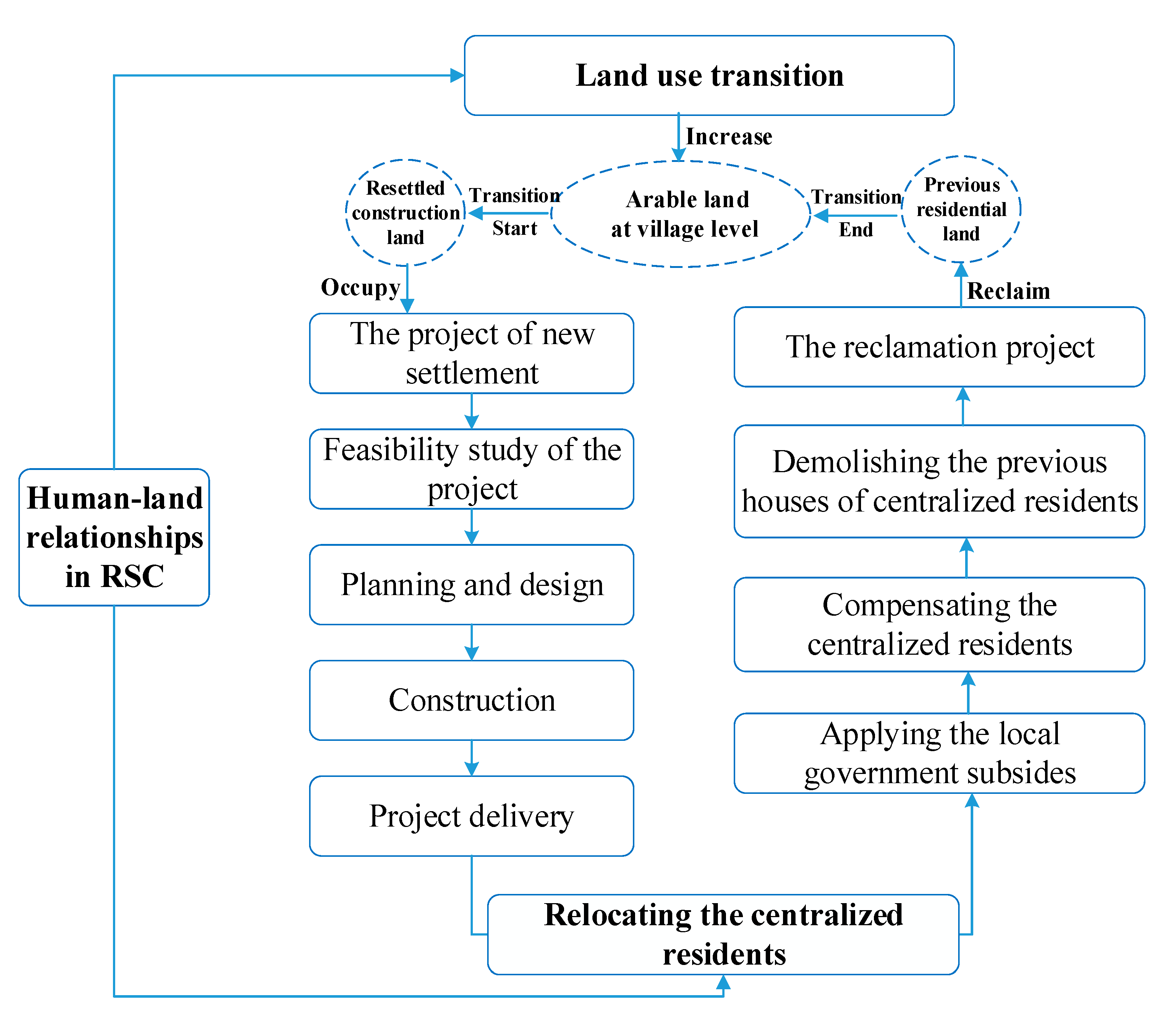
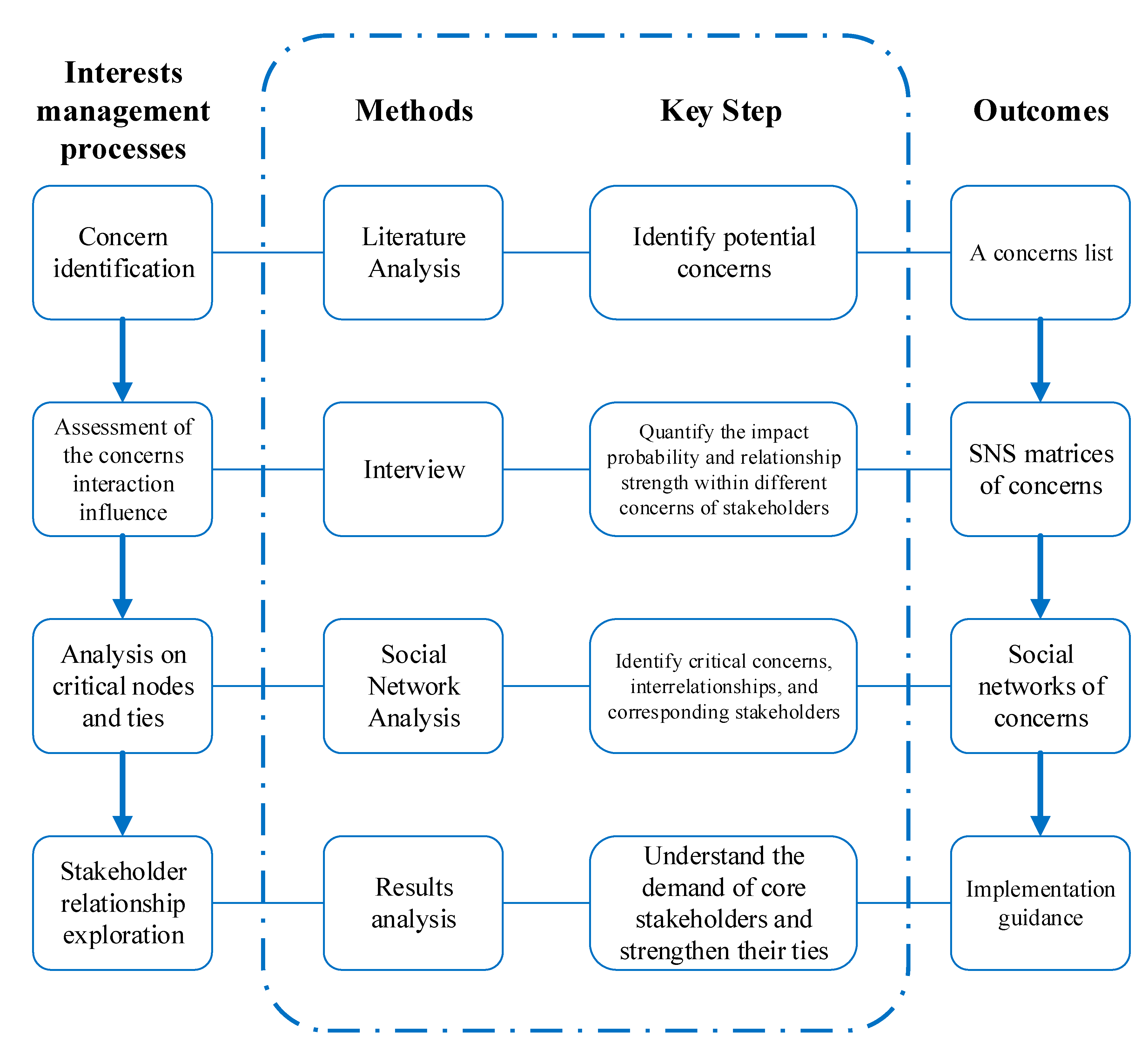
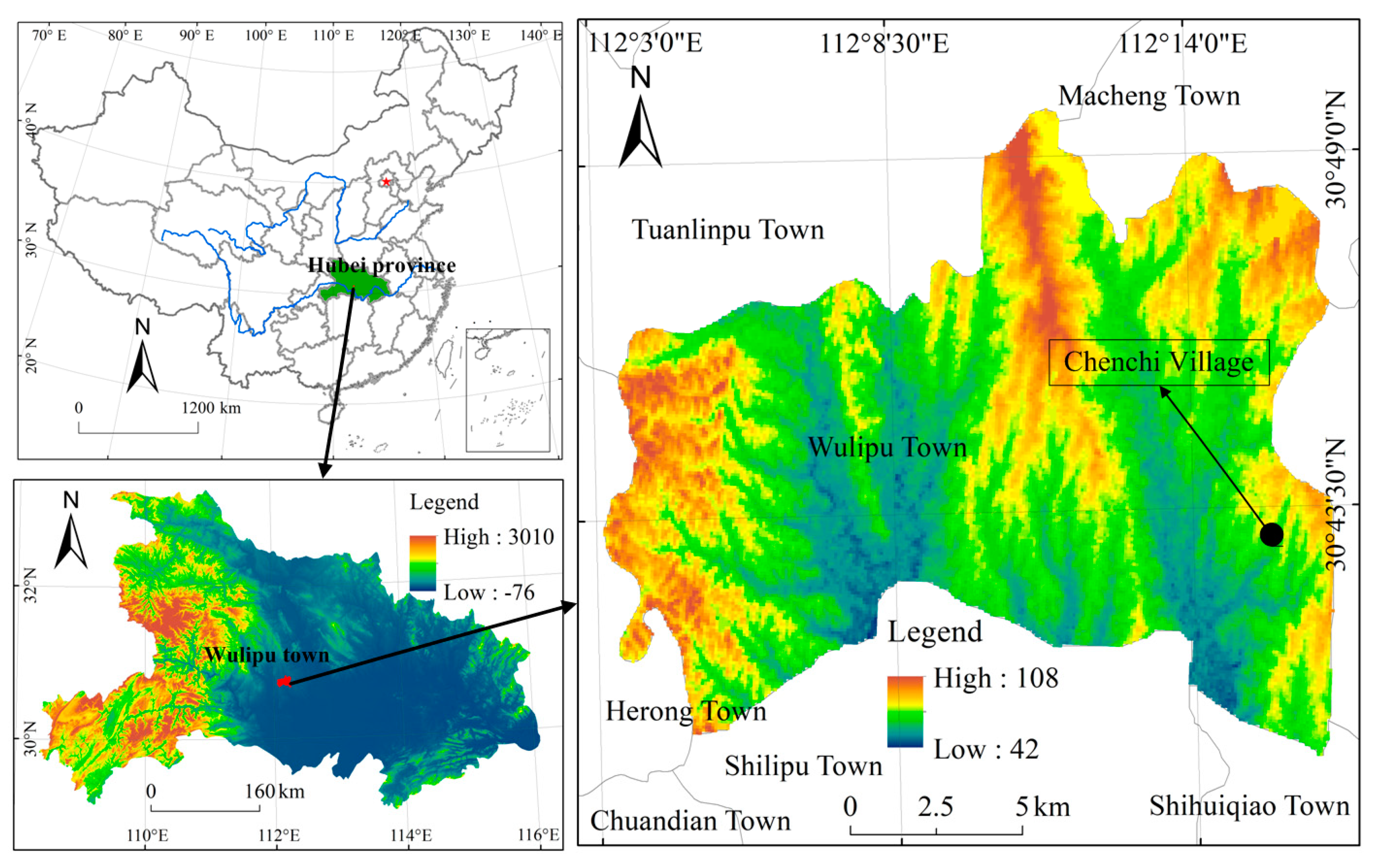
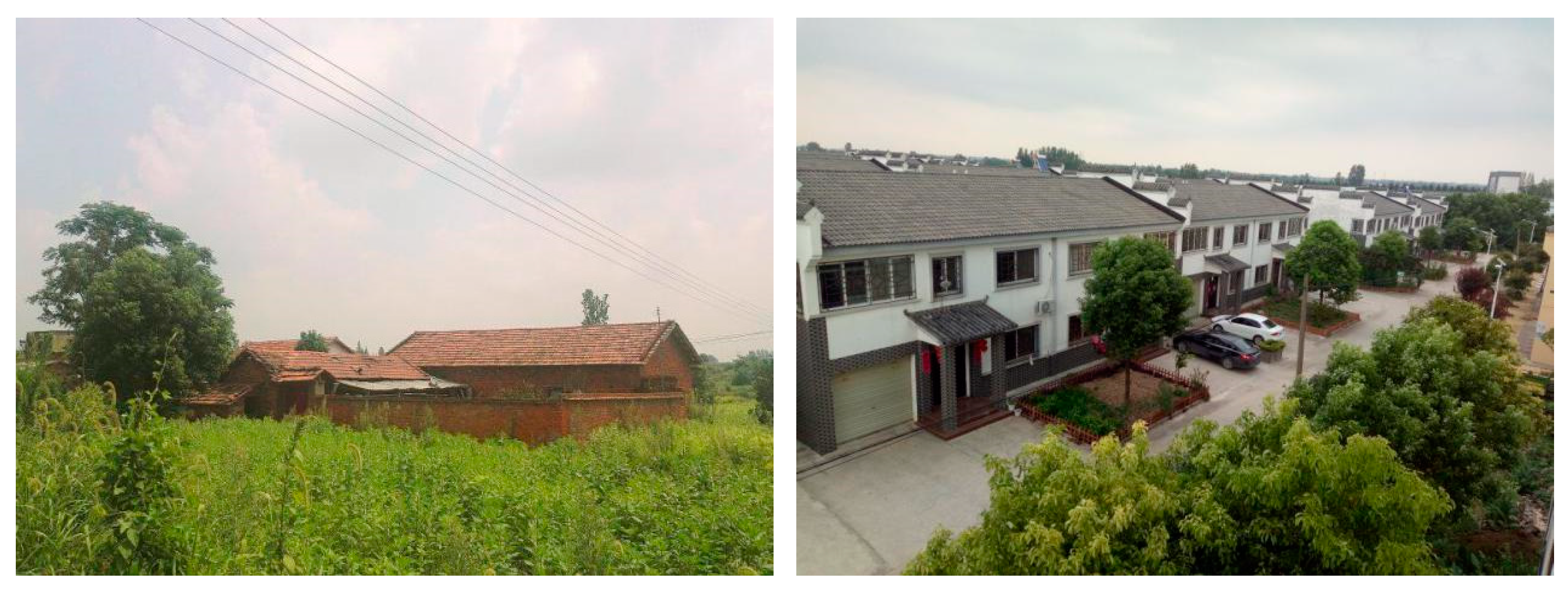
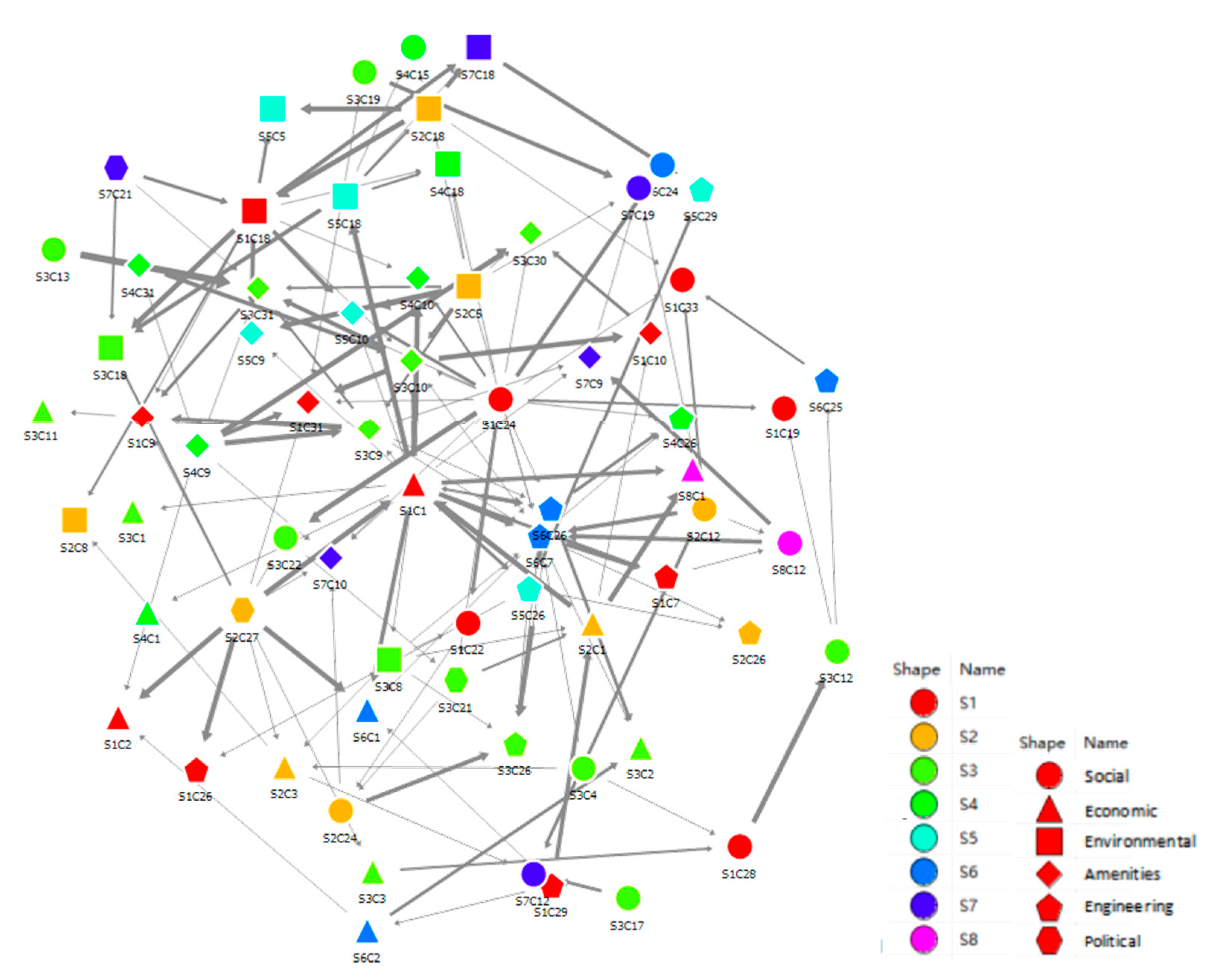
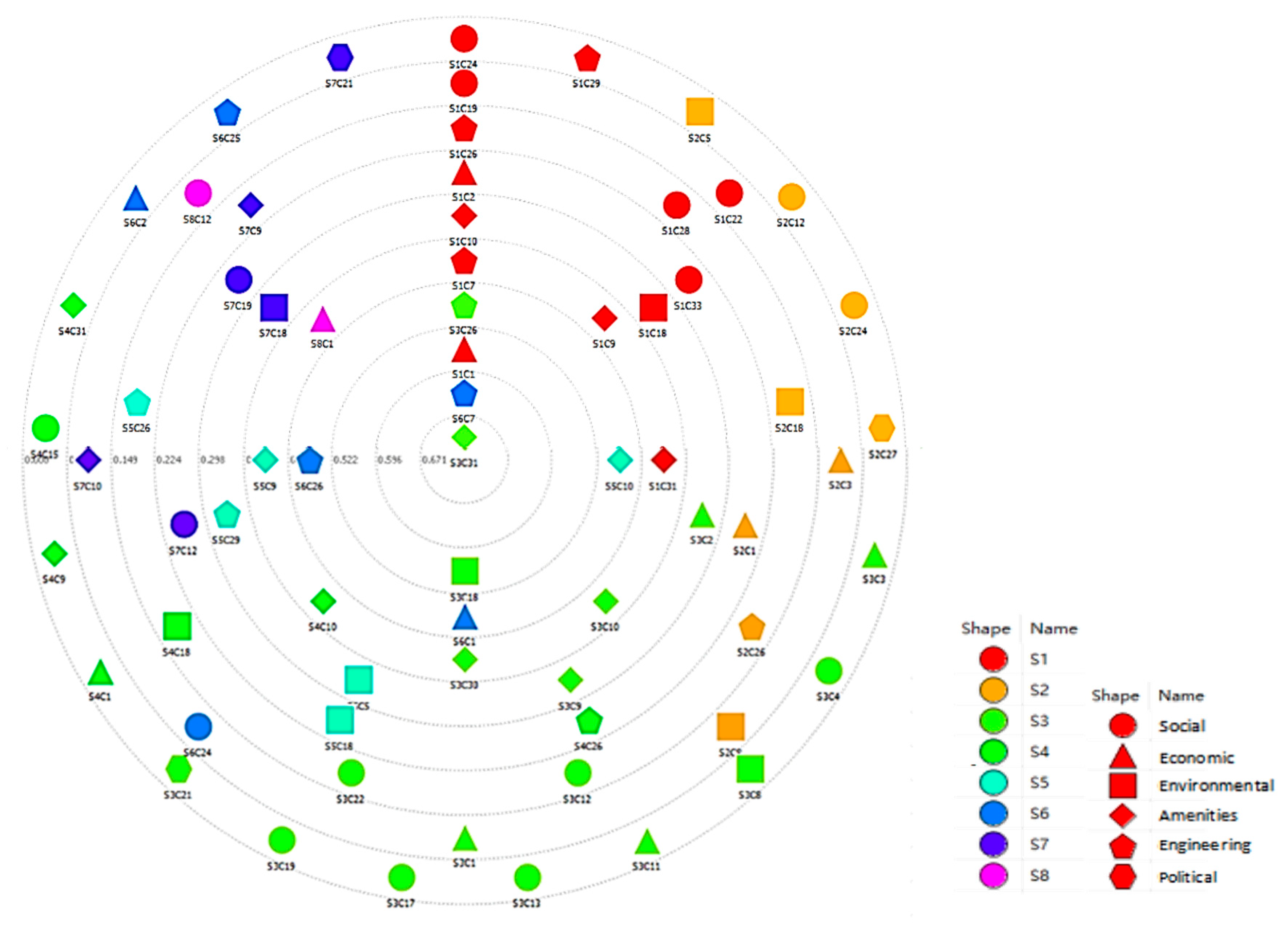
| Nodes of Stakeholders’ Concern | Stakeholders Code | Concern Code | Content of Concerns | References | Concern Category |
|---|---|---|---|---|---|
| S1C1;S2C1;S3C1;S4C1;S6C1;S8C1 | S1;S2;S3;S4;S6;S8 | C1 | Project finance | [69] | Economic |
| S1C2;S3C2;S6C2 | S1;S3;S6 | C2 | Cost control | [31,70] | Economic |
| S2C3;S3C3 | S2;S3 | C3 | Compensation method | [71] | Economic |
| S3C4 | S3 | C4 | Fair benefit distribution | [31] | Economic |
| S2C5;S5C5 | S2;S5 | C5 | Reasonable planning and design | [72] | Environmental |
| S2C6 | C6 | C6 | Reasonable compensation standard | [30,73] | Economic |
| S1C7;S6C7 | S1;S6 | C7 | Construction schedule | [48] | Engineering |
| S2C8;S3C8 | S2;S3 | C8 | Reasonable site selection | [74] | Engineering |
| S1C9;S3C9;S4C9;S5C9;S7C9 | S1;S3;S4;S5;S7 | C9 | Improvement of general public service | [75] | Amenities |
| S1C10;S3C10;S4C10;S5C10;S7C10 | S1;S3;S4;S5;S7 | C10 | Infrastructure improvement | [76] | Amenities |
| S3C11 | S3 | C11 | More job opportunities | [34] | Economic |
| S2C12;S3C12;S7C12;S8C12 | S2;S3;S7;S8 | C12 | Attention to group incidents | [77] | Social |
| S3C13 | S3 | C13 | Reinforcing neighborhood relationship | [36] | Social |
| S2C14;S3C14 | S2;S3 | C14 | Ownership disputes | [78] | Social |
| S4C15 | S4 | C15 | Sense of belonging | [5] | Social |
| S1C16;S2C16;S4C16 | S1;S2;S4 | C16 | Poverty reduction effect | [79] | Social |
| S3C17 | S3 | C17 | Avoiding violent demolition | [80] | Social |
| S1C18;S2C18;S3C18;S4C18;S5C18;S7C18 | S1;S2;S3;S4;S5;S7 | C18 | Preserving rural scenes | [55,81] | Environmental |
| S1C19;S3C19;S7C19 | S1;S3;S7 | C19 | Safety | [36] | Engineering |
| S3C20 | S3 | C20 | Rural residential property | [82] | Economic |
| S3C21;S7C21 | S3;S7 | C21 | Public policy | [83] | Political |
| S1C22;S3C22 | S1;S3 | C22 | Fair relocation | [28] | Engineering |
| S1C23;S7C23 | S1;S7 | C23 | Protection of folk customs | [13,81] | Social |
| S1C24;S2C24;S6C24 | S1;S2;S6 | C24 | Channels for stakeholder participation | [24,45] | Social |
| S6C25 | S6 | C25 | Avoiding construction accidents | Interview | Engineering |
| S1C26;S2C26;S3C26;S4C26;S5C26;S6C26 | S1;S2;S3;S4;S5;S6 | C26 | Housing quality | [23,51] | Engineering |
| S2C27 | S2 | C27 | Coherent policy | [36] | Political |
| S1C28 | S1 | C28 | Opposition and resistance of residents | [35] | Social |
| S1C29;S5C29 | S1;S5 | C29 | Feasibility study | [84] | Engineering |
| S3C30 | S3 | C30 | Improvement of production conditions | [85,85] | Amenities |
| S1C31;S3C31;S4C31 | S1;S3;S3 | C31 | Improvement of living conditions | [30,51] | Amenities |
| S3C32;S5C32 | S3;S5 | C32 | Upgrading agricultural facilities | [40] | Amenities |
| S1C33 | S1 | C33 | Political promotion | [86] | Social |
| Rank | SC | Degree Difference | SC | Out-Status Centrality | SC | Closeness Centrality | SC | Node Betweenness Centrality | Tie | Link Betweenness Centrality |
|---|---|---|---|---|---|---|---|---|---|---|
| 1 | S1C24 | 17 | S1C1 | 2.79 | S1C1 | 0.475 | S1C1 | 0.10 | S6C26→S1C1 | 250.83 |
| 2 | S1C1 | 14 | S2C27 | 2 | S6C26 | 0.366 | S6C26 | 0.05 | S2C1→S1C1 | 177.83 |
| 3 | S2C27 | 11 | S1C24 | 1.79 | S2C27 | 0.345 | S6C7 | 0.04 | S1C1→S5C18 | 133.00 |
| 4 | S2C5 | 10 | S2C5 | 1.39 | S2C1 | 0.324 | S2C1 | 0.03 | S3C26→S6C26 | 97.00 |
| 5 | S1C18 | 8 | S1C18 | 1.29 | S3C8 | 0.307 | S3C10 | 0.03 | S2C24→S3C26 | 93.67 |
| 6 | S4C9 | 7 | S2C1 | 1.28 | S6C7 | 0.306 | S5C18 | 0.03 | S1C1→S3C8 | 88.83 |
| 7 | S2C12 | 5 | S2C18 | 1.15 | S1C24 | 0.306 | S3C26 | 0.02 | S3C21→S2C1 | 83.33 |
| 8 | S3C8 | 4 | S6C26 | 1.05 | S3C9 | 0.303 | S3C9 | 0.02 | S5C18→S2C18 | 83.00 |
| 9 | S5C18 | 4 | S4C9 | 0.98 | S3C26 | 0.302 | S2C18 | 0.02 | S3C9→S6C26 | 75.00 |
| 10 | S5C26 | 4 | S5C26 | 0.81 | S3C10 | 0.282 | S3C8 | 0.02 | S6C7→S3C10 | 63.33 |
| 11 | S2C18 | 3 | S3C10 | 0.8 | S5C26 | 0.273 | S1C18 | 0.02 | S2C18→S1C18 | 63.00 |
| 12 | S1C29 | 3 | S2C12 | 0.74 | S2C5 | 0.255 | S2C24 | 0.01 | S1C22→S2C24 | 56.00 |
| 13 | S3C4 | 3 | S5C18 | 0.62 | S1C18 | 0.236 | S3C21 | 0.01 | S1C18→S3C10 | 55.00 |
| 14 | S7C21 | 3 | S1C29 | 0.53 | S3C21 | 0.233 | S1C7 | 0.01 | S1C7→S8C12 | 55.00 |
| 15 | S3C9 | 2 | S7C21 | 0.51 | S2C24 | 0.223 | S2C3 | 0.01 | S3C10→S6C7 | 54.00 |
| Type | Key Stakeholders’ Concerns/Ties | Stakeholders |
|---|---|---|
| Financing | S6C26→S1C1 | Contractor |
| S2C1→S1C1 | Township government | |
| S1C1→S5C18 | Village committee | |
| S1C1→S3C8 | Village committee | |
| S1C1→S3C9 | Village committee | |
| S1C1→S3C10 | Village committee | |
| S1C1 | Village committee | |
| S2C1 | Township government | |
| Psychological attachment | S5C18→S2C18 | Designer |
| S1C18→S3C10 | Village committee | |
| S2C18→S1C18 | Township government | |
| S4C15→S1C18 | The non-centralized | |
| S3C13→S1C18 | Centralized residents | |
| S5C18 | Designer | |
| S3C18 | Centralized residents | |
| S2C12 | Township government | |
| Stakeholder Participation | S2C24→S3C26 | Township government |
| S3C21→S2C1 | Centralized residents | |
| S1C24 | Village committee | |
| S7C21 | The general public | |
| Project management | S3C26→S6C26 | Centralized residents |
| S1C1→S6C26 | Village committee | |
| S3C9→S6C26 | Centralized residents | |
| S1C7→S8C12 | Village committee | |
| S6C7→S3C10 | Contractor | |
| S6C7 | Contractor | |
| S6C26 | Contractor | |
| The improvement of living conditions and infrastructure | S1C18→S3C10 | Village committee |
| S1C1→S3C10 | Village committee | |
| S1C24→S3C10 | Village committee | |
| S1C10→S3C30 | Village committee | |
| S1C9→S3C31 | Village committee | |
| S5C10 | Designer | |
| S3C31 | Centralized residents |
© 2020 by the authors. Licensee MDPI, Basel, Switzerland. This article is an open access article distributed under the terms and conditions of the Creative Commons Attribution (CC BY) license (http://creativecommons.org/licenses/by/4.0/).
Share and Cite
Yang, F.; Chi, G.; Wang, G.; Tang, S.; Li, Y.; Ju, C. Untangle the Complex Stakeholder Relationships in Rural Settlement Consolidation in China: A Social Network Approach. Land 2020, 9, 210. https://doi.org/10.3390/land9070210
Yang F, Chi G, Wang G, Tang S, Li Y, Ju C. Untangle the Complex Stakeholder Relationships in Rural Settlement Consolidation in China: A Social Network Approach. Land. 2020; 9(7):210. https://doi.org/10.3390/land9070210
Chicago/Turabian StyleYang, Fan, Guangqing Chi, Ge Wang, Shirui Tang, Yunting Li, and Cong Ju. 2020. "Untangle the Complex Stakeholder Relationships in Rural Settlement Consolidation in China: A Social Network Approach" Land 9, no. 7: 210. https://doi.org/10.3390/land9070210
APA StyleYang, F., Chi, G., Wang, G., Tang, S., Li, Y., & Ju, C. (2020). Untangle the Complex Stakeholder Relationships in Rural Settlement Consolidation in China: A Social Network Approach. Land, 9(7), 210. https://doi.org/10.3390/land9070210







